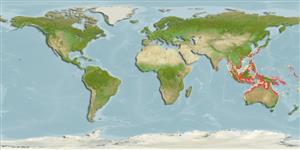Teleostei (teleosts) >
Callionymiformes (Dragonets) >
Callionymidae (Dragonets)
Etymology: Callionymus: Greek, kallion, comparative of kallos = beautiful + Greek, onyma = name; with a better name.
Eponymy: Admiral Sir Edward Belcher (1799–1877) was a British explorer. [...] (Ref. 128868), visit book page.
More on author: Richardson.
Issue
Issue on validity of subspecies: the subspecies Callionymus belcheri recurvispinnis is elevated as species rank as Callionymus recurvispinnis ((Li, 1966) in Eschmeyer (CofF ver. May 2011: Ref. 86870). The species page will be created.
Environment: milieu / climate zone / depth range / distribution range
Ecology
Marine; demersal; depth range 18 - 36 m (Ref. 75992). Tropical
Western Central Pacific: northwestern Australia and Papua New Guinea (Ref. 6192).
Length at first maturity / Size / Weight / Age
Maturity: Lm 7.5 range ? - ? cm
Max length : 10.0 cm SL male/unsexed; (Ref. 757); 10.0 cm SL (female)
Dorsal spines (total): 4; Dorsal soft rays (total): 9; Anal soft rays: 8. Head and body yellowish to brown. Back with many small white spots. Sides of body with white blotches surrounded with dark brown. Belly whitish first dorsal fin brownish, distal margin often blackish, in males with white spots. Second dorsal fin with light and dark streaks or small white spots. Anal fin in males with a dark streak, in females colourless or with distal dark spots. Lower two-thirds of caudal fin spotted with brown. Ventral margin of preopercular spine concave (Ref 42832).
Life cycle and mating behavior
Maturity | Reproduction | Spawning | Eggs | Fecundity | Larvae
Kailola, P.J., 1987. The fishes of Papua New Guinea: a revised and annotated checklist. Vol. II Scorpaenidae to Callionymidae. Research Bulletin No. 41, Research Section, Dept. of Fisheries and Marine Resources, Papua New Guinea. (Ref. 6192)
IUCN Red List Status (Ref. 130435: Version 2024-2)
Threat to humans
Harmless
Human uses
Fisheries: commercial; aquarium: commercial
Tools
Special reports
Download XML
Internet sources
Estimates based on models
Preferred temperature (Ref.
123201): 24.6 - 29.1, mean 28.3 °C (based on 430 cells).
Phylogenetic diversity index (Ref.
82804): PD
50 = 0.5000 [Uniqueness, from 0.5 = low to 2.0 = high].
Bayesian length-weight: a=0.00692 (0.00397 - 0.01205), b=2.83 (2.68 - 2.98), in cm total length, based on LWR estimates for this species & Genus-body shape (Ref.
93245).
Trophic level (Ref.
69278): 3.3 ±0.4 se; based on size and trophs of closest relatives
Generation time: 2.3 ( na - na) years. Estimated as median ln(3)/K based on 1
growth studies.
Resilience (Ref.
120179): High, minimum population doubling time less than 15 months (K=0.41-0.48; tmax=3).
Fishing Vulnerability (Ref.
59153): Low to moderate vulnerability (26 of 100).
